A Critical Analysis: Marketing Orientation and Organizational Success
VerifiedAdded on 2023/05/31
|10
|2634
|409
Essay
AI Summary
This essay critically evaluates the concept of marketing orientation, examining its various components such as customer orientation, competitor orientation, interfunctional coordination, organizational culture, and long-term creation of shareholder value. It relates these components to other business orientations, emphasizing the importance of customer understanding, sales strategies, and competitive awareness for achieving organizational success. The essay further discusses the significance of a positive organizational culture and coordinated production processes in enhancing productivity and profitability. Drawing from academic literature, the analysis underscores the supremacy of a marketing orientation in driving business growth and maintaining a competitive edge, concluding that a holistic approach to marketing, incorporating customer focus and strategic alignment, is essential for companies to achieve their goals and targets in the competitive market.

Running head: Strategic management
Strategic management
Strategic management
Paraphrase This Document
Need a fresh take? Get an instant paraphrase of this document with our AI Paraphraser
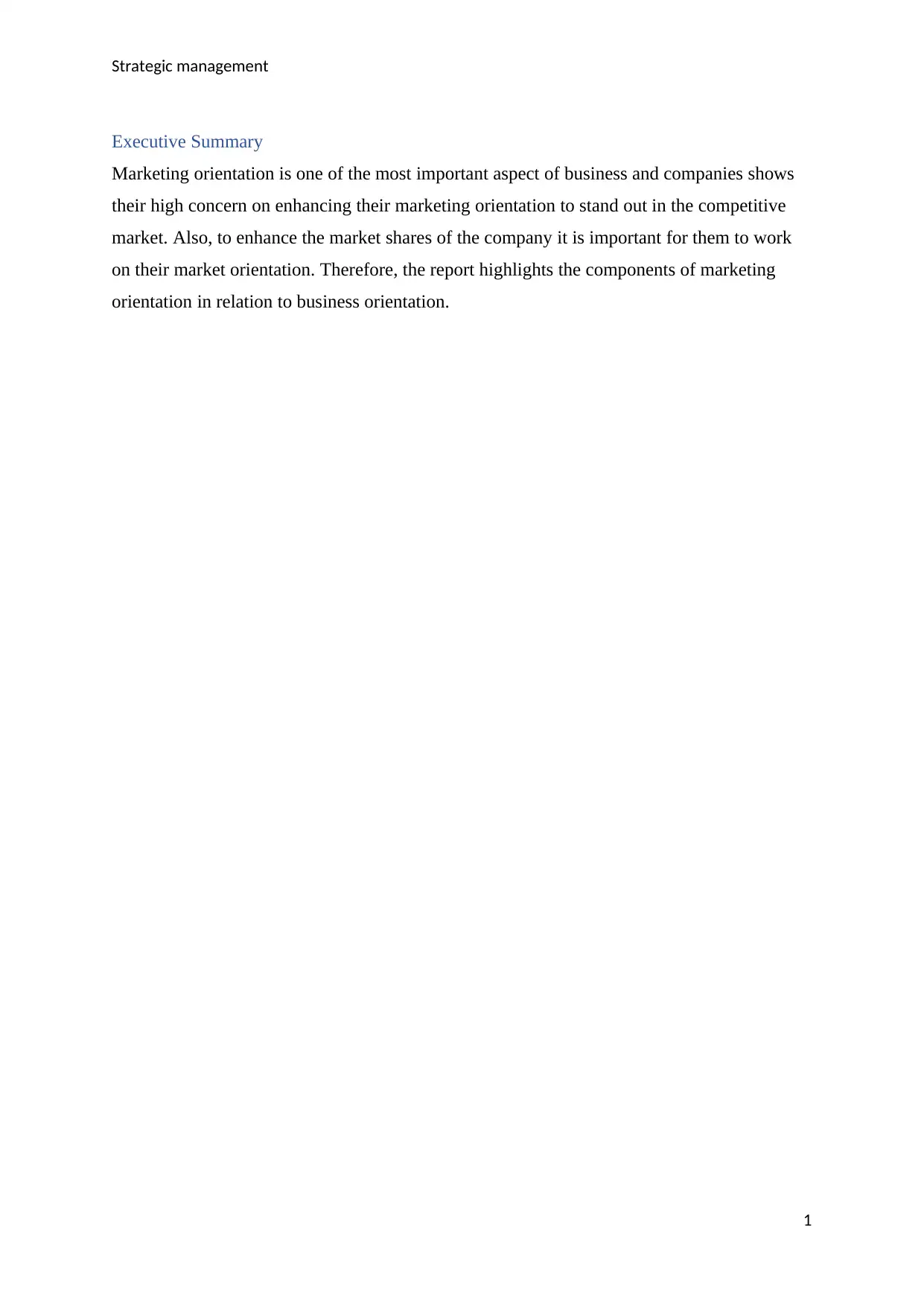
Strategic management
Executive Summary
Marketing orientation is one of the most important aspect of business and companies shows
their high concern on enhancing their marketing orientation to stand out in the competitive
market. Also, to enhance the market shares of the company it is important for them to work
on their market orientation. Therefore, the report highlights the components of marketing
orientation in relation to business orientation.
1
Executive Summary
Marketing orientation is one of the most important aspect of business and companies shows
their high concern on enhancing their marketing orientation to stand out in the competitive
market. Also, to enhance the market shares of the company it is important for them to work
on their market orientation. Therefore, the report highlights the components of marketing
orientation in relation to business orientation.
1
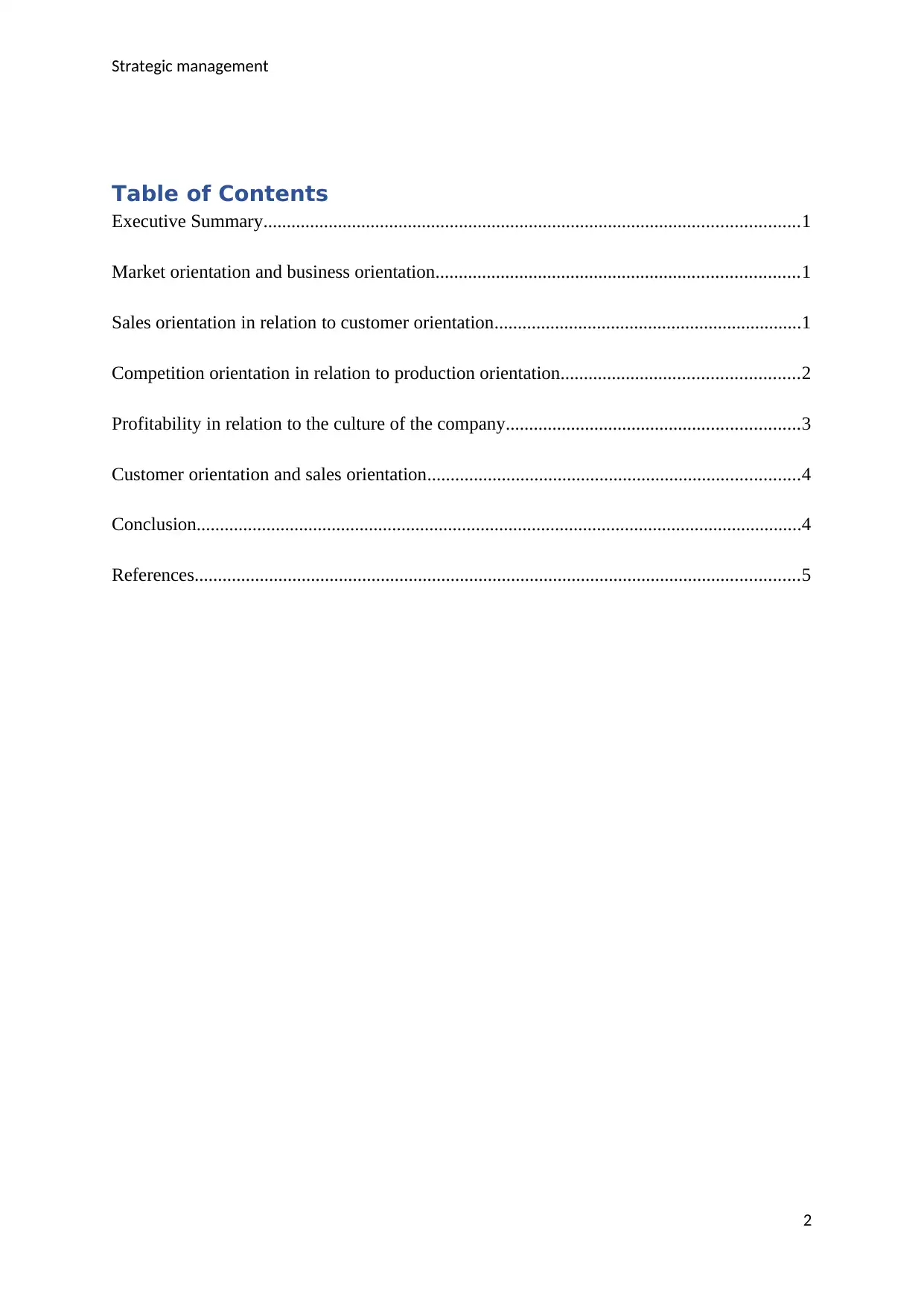
Strategic management
Table of Contents
Executive Summary...................................................................................................................1
Market orientation and business orientation..............................................................................1
Sales orientation in relation to customer orientation..................................................................1
Competition orientation in relation to production orientation...................................................2
Profitability in relation to the culture of the company...............................................................3
Customer orientation and sales orientation................................................................................4
Conclusion..................................................................................................................................4
References..................................................................................................................................5
2
Table of Contents
Executive Summary...................................................................................................................1
Market orientation and business orientation..............................................................................1
Sales orientation in relation to customer orientation..................................................................1
Competition orientation in relation to production orientation...................................................2
Profitability in relation to the culture of the company...............................................................3
Customer orientation and sales orientation................................................................................4
Conclusion..................................................................................................................................4
References..................................................................................................................................5
2
⊘ This is a preview!⊘
Do you want full access?
Subscribe today to unlock all pages.

Trusted by 1+ million students worldwide
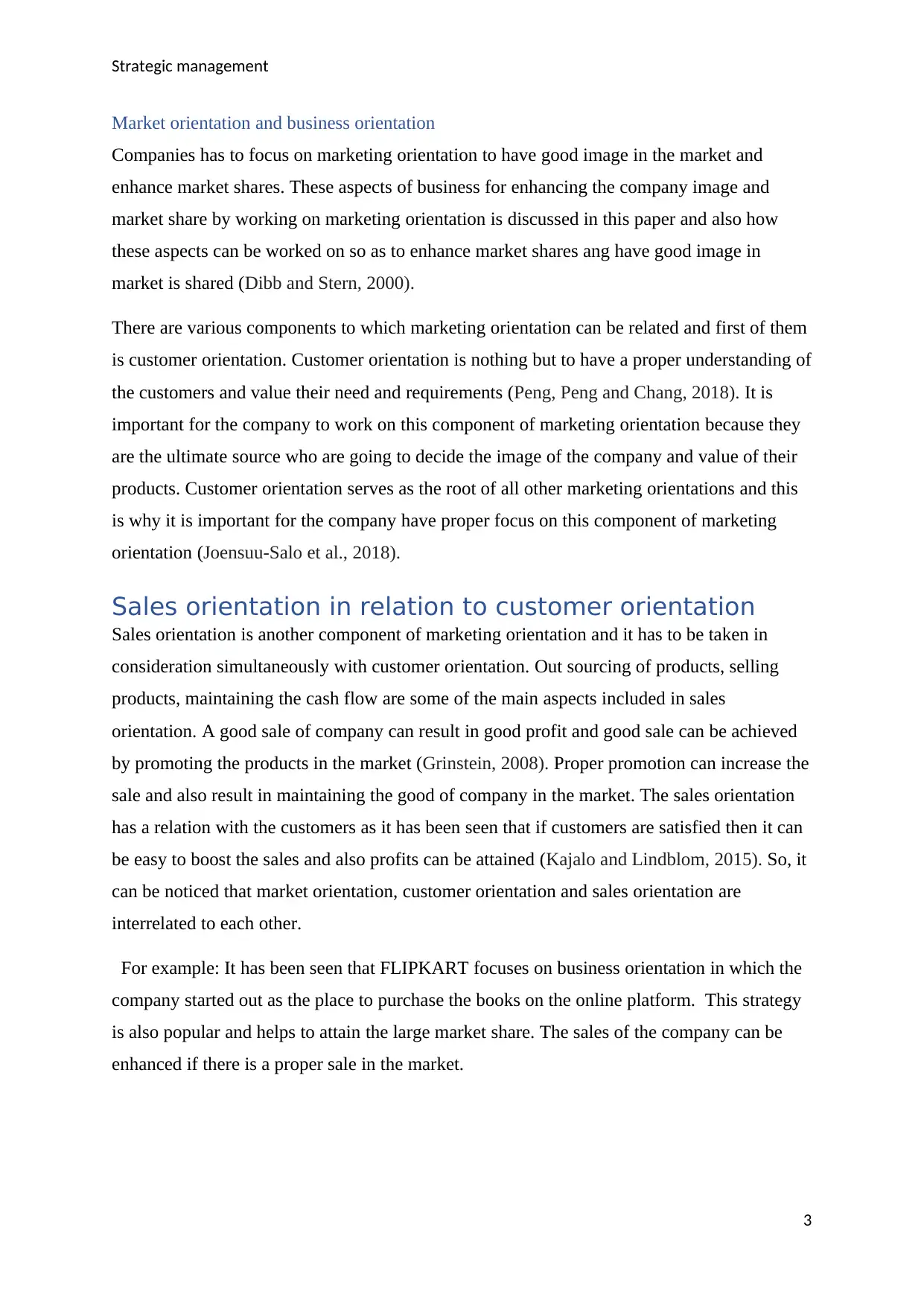
Strategic management
Market orientation and business orientation
Companies has to focus on marketing orientation to have good image in the market and
enhance market shares. These aspects of business for enhancing the company image and
market share by working on marketing orientation is discussed in this paper and also how
these aspects can be worked on so as to enhance market shares ang have good image in
market is shared (Dibb and Stern, 2000).
There are various components to which marketing orientation can be related and first of them
is customer orientation. Customer orientation is nothing but to have a proper understanding of
the customers and value their need and requirements (Peng, Peng and Chang, 2018). It is
important for the company to work on this component of marketing orientation because they
are the ultimate source who are going to decide the image of the company and value of their
products. Customer orientation serves as the root of all other marketing orientations and this
is why it is important for the company have proper focus on this component of marketing
orientation (Joensuu-Salo et al., 2018).
Sales orientation in relation to customer orientation
Sales orientation is another component of marketing orientation and it has to be taken in
consideration simultaneously with customer orientation. Out sourcing of products, selling
products, maintaining the cash flow are some of the main aspects included in sales
orientation. A good sale of company can result in good profit and good sale can be achieved
by promoting the products in the market (Grinstein, 2008). Proper promotion can increase the
sale and also result in maintaining the good of company in the market. The sales orientation
has a relation with the customers as it has been seen that if customers are satisfied then it can
be easy to boost the sales and also profits can be attained (Kajalo and Lindblom, 2015). So, it
can be noticed that market orientation, customer orientation and sales orientation are
interrelated to each other.
For example: It has been seen that FLIPKART focuses on business orientation in which the
company started out as the place to purchase the books on the online platform. This strategy
is also popular and helps to attain the large market share. The sales of the company can be
enhanced if there is a proper sale in the market.
3
Market orientation and business orientation
Companies has to focus on marketing orientation to have good image in the market and
enhance market shares. These aspects of business for enhancing the company image and
market share by working on marketing orientation is discussed in this paper and also how
these aspects can be worked on so as to enhance market shares ang have good image in
market is shared (Dibb and Stern, 2000).
There are various components to which marketing orientation can be related and first of them
is customer orientation. Customer orientation is nothing but to have a proper understanding of
the customers and value their need and requirements (Peng, Peng and Chang, 2018). It is
important for the company to work on this component of marketing orientation because they
are the ultimate source who are going to decide the image of the company and value of their
products. Customer orientation serves as the root of all other marketing orientations and this
is why it is important for the company have proper focus on this component of marketing
orientation (Joensuu-Salo et al., 2018).
Sales orientation in relation to customer orientation
Sales orientation is another component of marketing orientation and it has to be taken in
consideration simultaneously with customer orientation. Out sourcing of products, selling
products, maintaining the cash flow are some of the main aspects included in sales
orientation. A good sale of company can result in good profit and good sale can be achieved
by promoting the products in the market (Grinstein, 2008). Proper promotion can increase the
sale and also result in maintaining the good of company in the market. The sales orientation
has a relation with the customers as it has been seen that if customers are satisfied then it can
be easy to boost the sales and also profits can be attained (Kajalo and Lindblom, 2015). So, it
can be noticed that market orientation, customer orientation and sales orientation are
interrelated to each other.
For example: It has been seen that FLIPKART focuses on business orientation in which the
company started out as the place to purchase the books on the online platform. This strategy
is also popular and helps to attain the large market share. The sales of the company can be
enhanced if there is a proper sale in the market.
3
Paraphrase This Document
Need a fresh take? Get an instant paraphrase of this document with our AI Paraphraser
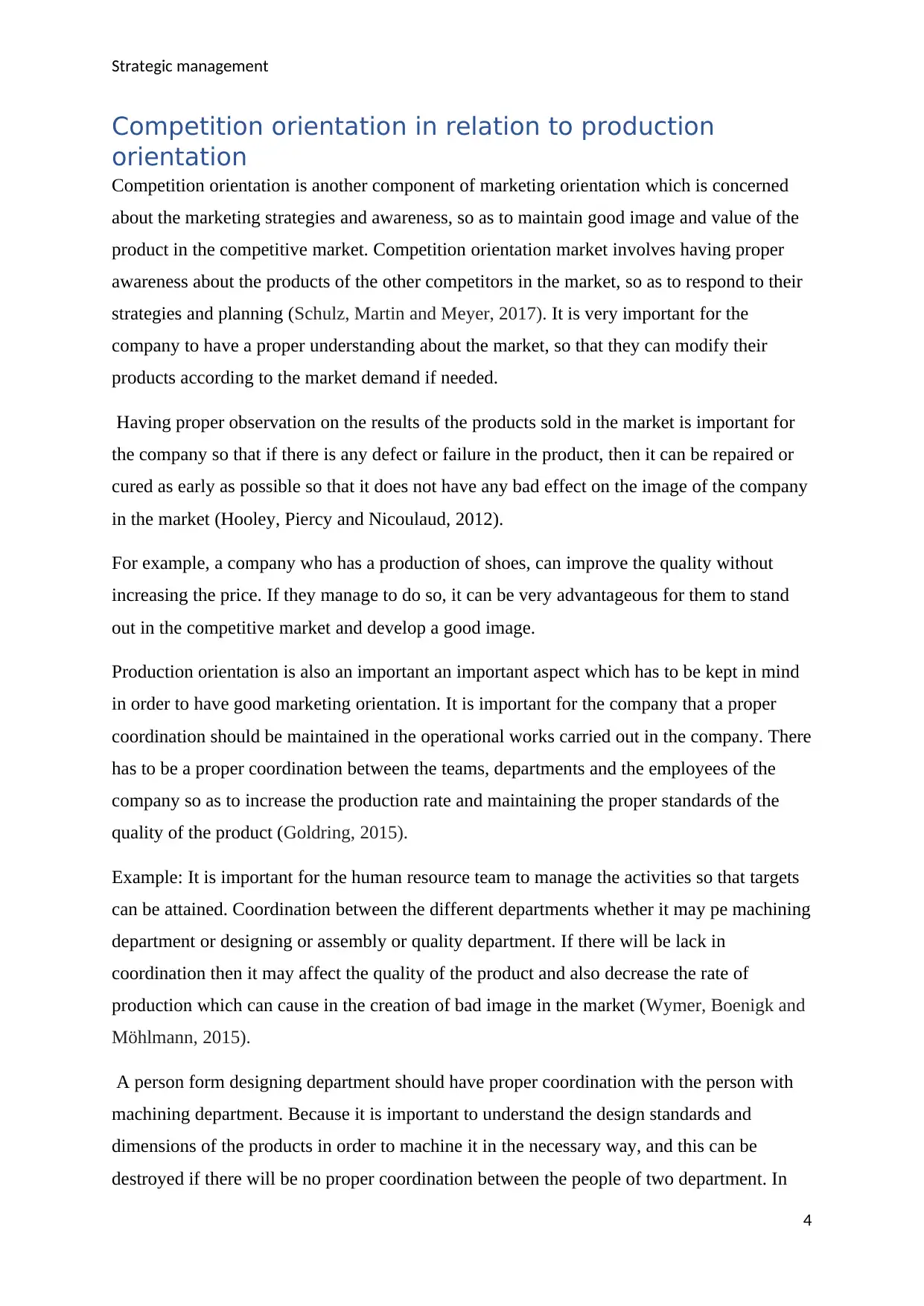
Strategic management
Competition orientation in relation to production
orientation
Competition orientation is another component of marketing orientation which is concerned
about the marketing strategies and awareness, so as to maintain good image and value of the
product in the competitive market. Competition orientation market involves having proper
awareness about the products of the other competitors in the market, so as to respond to their
strategies and planning (Schulz, Martin and Meyer, 2017). It is very important for the
company to have a proper understanding about the market, so that they can modify their
products according to the market demand if needed.
Having proper observation on the results of the products sold in the market is important for
the company so that if there is any defect or failure in the product, then it can be repaired or
cured as early as possible so that it does not have any bad effect on the image of the company
in the market (Hooley, Piercy and Nicoulaud, 2012).
For example, a company who has a production of shoes, can improve the quality without
increasing the price. If they manage to do so, it can be very advantageous for them to stand
out in the competitive market and develop a good image.
Production orientation is also an important an important aspect which has to be kept in mind
in order to have good marketing orientation. It is important for the company that a proper
coordination should be maintained in the operational works carried out in the company. There
has to be a proper coordination between the teams, departments and the employees of the
company so as to increase the production rate and maintaining the proper standards of the
quality of the product (Goldring, 2015).
Example: It is important for the human resource team to manage the activities so that targets
can be attained. Coordination between the different departments whether it may pe machining
department or designing or assembly or quality department. If there will be lack in
coordination then it may affect the quality of the product and also decrease the rate of
production which can cause in the creation of bad image in the market (Wymer, Boenigk and
Möhlmann, 2015).
A person form designing department should have proper coordination with the person with
machining department. Because it is important to understand the design standards and
dimensions of the products in order to machine it in the necessary way, and this can be
destroyed if there will be no proper coordination between the people of two department. In
4
Competition orientation in relation to production
orientation
Competition orientation is another component of marketing orientation which is concerned
about the marketing strategies and awareness, so as to maintain good image and value of the
product in the competitive market. Competition orientation market involves having proper
awareness about the products of the other competitors in the market, so as to respond to their
strategies and planning (Schulz, Martin and Meyer, 2017). It is very important for the
company to have a proper understanding about the market, so that they can modify their
products according to the market demand if needed.
Having proper observation on the results of the products sold in the market is important for
the company so that if there is any defect or failure in the product, then it can be repaired or
cured as early as possible so that it does not have any bad effect on the image of the company
in the market (Hooley, Piercy and Nicoulaud, 2012).
For example, a company who has a production of shoes, can improve the quality without
increasing the price. If they manage to do so, it can be very advantageous for them to stand
out in the competitive market and develop a good image.
Production orientation is also an important an important aspect which has to be kept in mind
in order to have good marketing orientation. It is important for the company that a proper
coordination should be maintained in the operational works carried out in the company. There
has to be a proper coordination between the teams, departments and the employees of the
company so as to increase the production rate and maintaining the proper standards of the
quality of the product (Goldring, 2015).
Example: It is important for the human resource team to manage the activities so that targets
can be attained. Coordination between the different departments whether it may pe machining
department or designing or assembly or quality department. If there will be lack in
coordination then it may affect the quality of the product and also decrease the rate of
production which can cause in the creation of bad image in the market (Wymer, Boenigk and
Möhlmann, 2015).
A person form designing department should have proper coordination with the person with
machining department. Because it is important to understand the design standards and
dimensions of the products in order to machine it in the necessary way, and this can be
destroyed if there will be no proper coordination between the people of two department. In
4
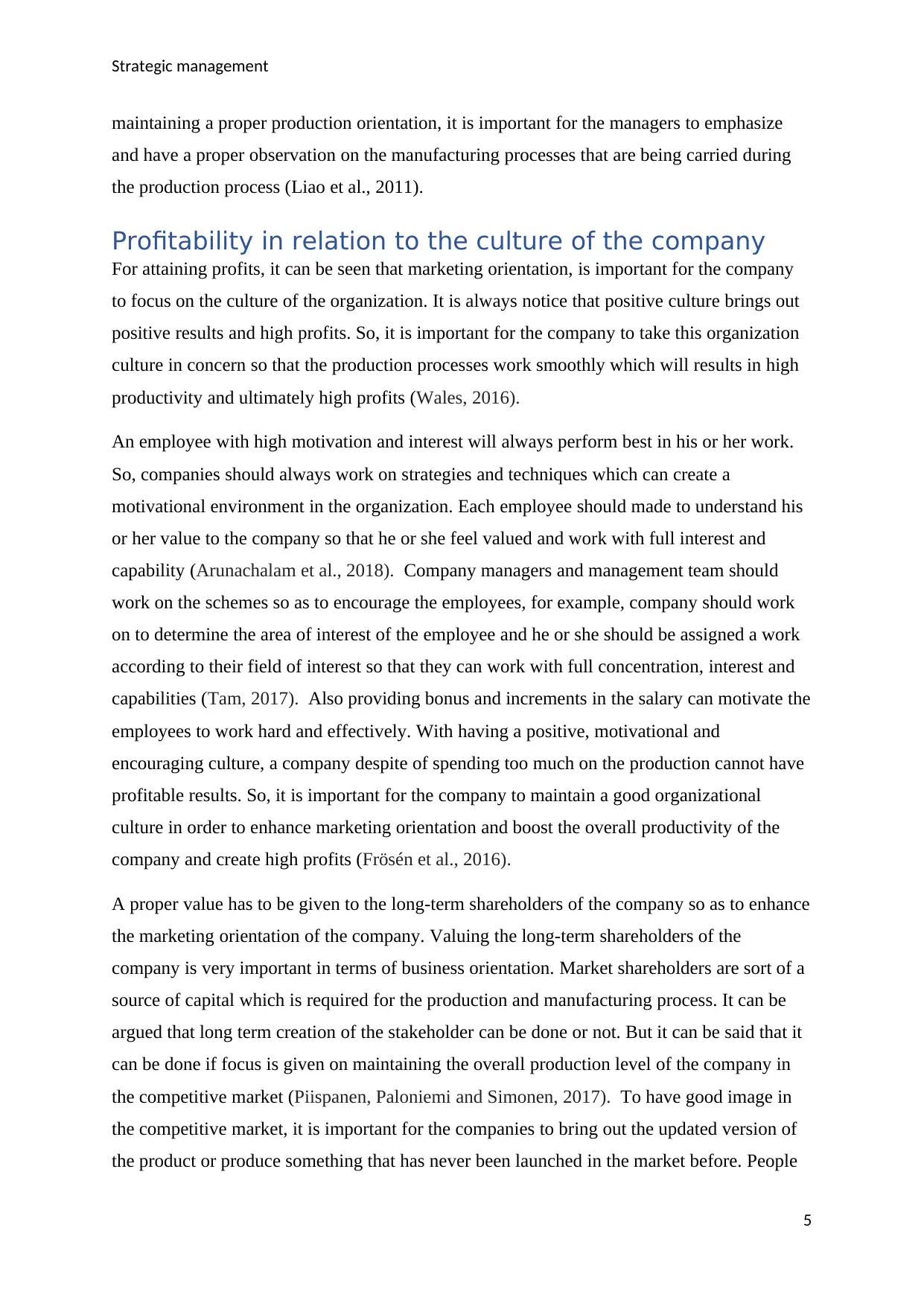
Strategic management
maintaining a proper production orientation, it is important for the managers to emphasize
and have a proper observation on the manufacturing processes that are being carried during
the production process (Liao et al., 2011).
Profitability in relation to the culture of the company
For attaining profits, it can be seen that marketing orientation, is important for the company
to focus on the culture of the organization. It is always notice that positive culture brings out
positive results and high profits. So, it is important for the company to take this organization
culture in concern so that the production processes work smoothly which will results in high
productivity and ultimately high profits (Wales, 2016).
An employee with high motivation and interest will always perform best in his or her work.
So, companies should always work on strategies and techniques which can create a
motivational environment in the organization. Each employee should made to understand his
or her value to the company so that he or she feel valued and work with full interest and
capability (Arunachalam et al., 2018). Company managers and management team should
work on the schemes so as to encourage the employees, for example, company should work
on to determine the area of interest of the employee and he or she should be assigned a work
according to their field of interest so that they can work with full concentration, interest and
capabilities (Tam, 2017). Also providing bonus and increments in the salary can motivate the
employees to work hard and effectively. With having a positive, motivational and
encouraging culture, a company despite of spending too much on the production cannot have
profitable results. So, it is important for the company to maintain a good organizational
culture in order to enhance marketing orientation and boost the overall productivity of the
company and create high profits (Frösén et al., 2016).
A proper value has to be given to the long-term shareholders of the company so as to enhance
the marketing orientation of the company. Valuing the long-term shareholders of the
company is very important in terms of business orientation. Market shareholders are sort of a
source of capital which is required for the production and manufacturing process. It can be
argued that long term creation of the stakeholder can be done or not. But it can be said that it
can be done if focus is given on maintaining the overall production level of the company in
the competitive market (Piispanen, Paloniemi and Simonen, 2017). To have good image in
the competitive market, it is important for the companies to bring out the updated version of
the product or produce something that has never been launched in the market before. People
5
maintaining a proper production orientation, it is important for the managers to emphasize
and have a proper observation on the manufacturing processes that are being carried during
the production process (Liao et al., 2011).
Profitability in relation to the culture of the company
For attaining profits, it can be seen that marketing orientation, is important for the company
to focus on the culture of the organization. It is always notice that positive culture brings out
positive results and high profits. So, it is important for the company to take this organization
culture in concern so that the production processes work smoothly which will results in high
productivity and ultimately high profits (Wales, 2016).
An employee with high motivation and interest will always perform best in his or her work.
So, companies should always work on strategies and techniques which can create a
motivational environment in the organization. Each employee should made to understand his
or her value to the company so that he or she feel valued and work with full interest and
capability (Arunachalam et al., 2018). Company managers and management team should
work on the schemes so as to encourage the employees, for example, company should work
on to determine the area of interest of the employee and he or she should be assigned a work
according to their field of interest so that they can work with full concentration, interest and
capabilities (Tam, 2017). Also providing bonus and increments in the salary can motivate the
employees to work hard and effectively. With having a positive, motivational and
encouraging culture, a company despite of spending too much on the production cannot have
profitable results. So, it is important for the company to maintain a good organizational
culture in order to enhance marketing orientation and boost the overall productivity of the
company and create high profits (Frösén et al., 2016).
A proper value has to be given to the long-term shareholders of the company so as to enhance
the marketing orientation of the company. Valuing the long-term shareholders of the
company is very important in terms of business orientation. Market shareholders are sort of a
source of capital which is required for the production and manufacturing process. It can be
argued that long term creation of the stakeholder can be done or not. But it can be said that it
can be done if focus is given on maintaining the overall production level of the company in
the competitive market (Piispanen, Paloniemi and Simonen, 2017). To have good image in
the competitive market, it is important for the companies to bring out the updated version of
the product or produce something that has never been launched in the market before. People
5
⊘ This is a preview!⊘
Do you want full access?
Subscribe today to unlock all pages.

Trusted by 1+ million students worldwide
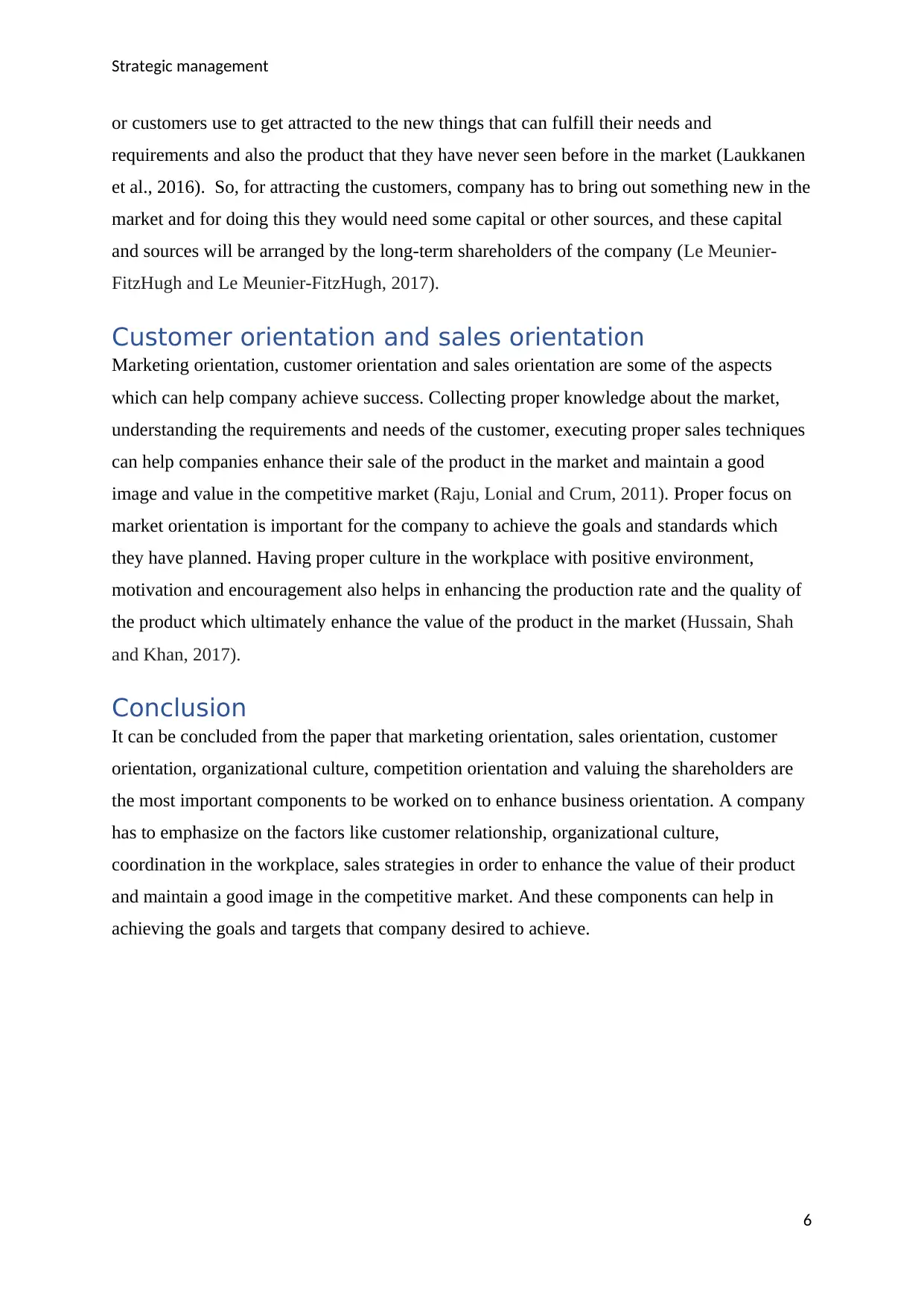
Strategic management
or customers use to get attracted to the new things that can fulfill their needs and
requirements and also the product that they have never seen before in the market (Laukkanen
et al., 2016). So, for attracting the customers, company has to bring out something new in the
market and for doing this they would need some capital or other sources, and these capital
and sources will be arranged by the long-term shareholders of the company (Le Meunier-
FitzHugh and Le Meunier-FitzHugh, 2017).
Customer orientation and sales orientation
Marketing orientation, customer orientation and sales orientation are some of the aspects
which can help company achieve success. Collecting proper knowledge about the market,
understanding the requirements and needs of the customer, executing proper sales techniques
can help companies enhance their sale of the product in the market and maintain a good
image and value in the competitive market (Raju, Lonial and Crum, 2011). Proper focus on
market orientation is important for the company to achieve the goals and standards which
they have planned. Having proper culture in the workplace with positive environment,
motivation and encouragement also helps in enhancing the production rate and the quality of
the product which ultimately enhance the value of the product in the market (Hussain, Shah
and Khan, 2017).
Conclusion
It can be concluded from the paper that marketing orientation, sales orientation, customer
orientation, organizational culture, competition orientation and valuing the shareholders are
the most important components to be worked on to enhance business orientation. A company
has to emphasize on the factors like customer relationship, organizational culture,
coordination in the workplace, sales strategies in order to enhance the value of their product
and maintain a good image in the competitive market. And these components can help in
achieving the goals and targets that company desired to achieve.
6
or customers use to get attracted to the new things that can fulfill their needs and
requirements and also the product that they have never seen before in the market (Laukkanen
et al., 2016). So, for attracting the customers, company has to bring out something new in the
market and for doing this they would need some capital or other sources, and these capital
and sources will be arranged by the long-term shareholders of the company (Le Meunier-
FitzHugh and Le Meunier-FitzHugh, 2017).
Customer orientation and sales orientation
Marketing orientation, customer orientation and sales orientation are some of the aspects
which can help company achieve success. Collecting proper knowledge about the market,
understanding the requirements and needs of the customer, executing proper sales techniques
can help companies enhance their sale of the product in the market and maintain a good
image and value in the competitive market (Raju, Lonial and Crum, 2011). Proper focus on
market orientation is important for the company to achieve the goals and standards which
they have planned. Having proper culture in the workplace with positive environment,
motivation and encouragement also helps in enhancing the production rate and the quality of
the product which ultimately enhance the value of the product in the market (Hussain, Shah
and Khan, 2017).
Conclusion
It can be concluded from the paper that marketing orientation, sales orientation, customer
orientation, organizational culture, competition orientation and valuing the shareholders are
the most important components to be worked on to enhance business orientation. A company
has to emphasize on the factors like customer relationship, organizational culture,
coordination in the workplace, sales strategies in order to enhance the value of their product
and maintain a good image in the competitive market. And these components can help in
achieving the goals and targets that company desired to achieve.
6
Paraphrase This Document
Need a fresh take? Get an instant paraphrase of this document with our AI Paraphraser
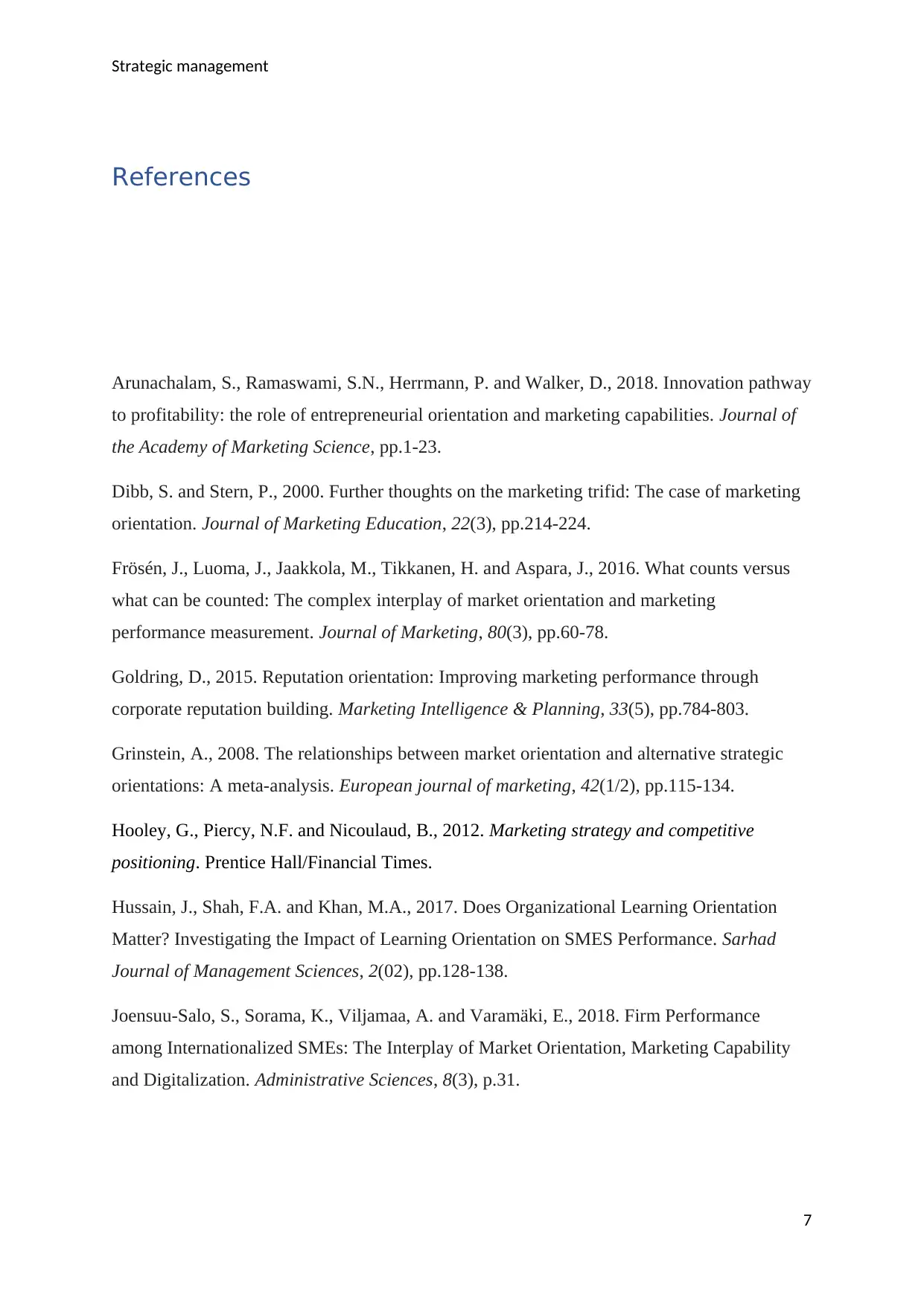
Strategic management
References
Arunachalam, S., Ramaswami, S.N., Herrmann, P. and Walker, D., 2018. Innovation pathway
to profitability: the role of entrepreneurial orientation and marketing capabilities. Journal of
the Academy of Marketing Science, pp.1-23.
Dibb, S. and Stern, P., 2000. Further thoughts on the marketing trifid: The case of marketing
orientation. Journal of Marketing Education, 22(3), pp.214-224.
Frösén, J., Luoma, J., Jaakkola, M., Tikkanen, H. and Aspara, J., 2016. What counts versus
what can be counted: The complex interplay of market orientation and marketing
performance measurement. Journal of Marketing, 80(3), pp.60-78.
Goldring, D., 2015. Reputation orientation: Improving marketing performance through
corporate reputation building. Marketing Intelligence & Planning, 33(5), pp.784-803.
Grinstein, A., 2008. The relationships between market orientation and alternative strategic
orientations: A meta-analysis. European journal of marketing, 42(1/2), pp.115-134.
Hooley, G., Piercy, N.F. and Nicoulaud, B., 2012. Marketing strategy and competitive
positioning. Prentice Hall/Financial Times.
Hussain, J., Shah, F.A. and Khan, M.A., 2017. Does Organizational Learning Orientation
Matter? Investigating the Impact of Learning Orientation on SMES Performance. Sarhad
Journal of Management Sciences, 2(02), pp.128-138.
Joensuu-Salo, S., Sorama, K., Viljamaa, A. and Varamäki, E., 2018. Firm Performance
among Internationalized SMEs: The Interplay of Market Orientation, Marketing Capability
and Digitalization. Administrative Sciences, 8(3), p.31.
7
References
Arunachalam, S., Ramaswami, S.N., Herrmann, P. and Walker, D., 2018. Innovation pathway
to profitability: the role of entrepreneurial orientation and marketing capabilities. Journal of
the Academy of Marketing Science, pp.1-23.
Dibb, S. and Stern, P., 2000. Further thoughts on the marketing trifid: The case of marketing
orientation. Journal of Marketing Education, 22(3), pp.214-224.
Frösén, J., Luoma, J., Jaakkola, M., Tikkanen, H. and Aspara, J., 2016. What counts versus
what can be counted: The complex interplay of market orientation and marketing
performance measurement. Journal of Marketing, 80(3), pp.60-78.
Goldring, D., 2015. Reputation orientation: Improving marketing performance through
corporate reputation building. Marketing Intelligence & Planning, 33(5), pp.784-803.
Grinstein, A., 2008. The relationships between market orientation and alternative strategic
orientations: A meta-analysis. European journal of marketing, 42(1/2), pp.115-134.
Hooley, G., Piercy, N.F. and Nicoulaud, B., 2012. Marketing strategy and competitive
positioning. Prentice Hall/Financial Times.
Hussain, J., Shah, F.A. and Khan, M.A., 2017. Does Organizational Learning Orientation
Matter? Investigating the Impact of Learning Orientation on SMES Performance. Sarhad
Journal of Management Sciences, 2(02), pp.128-138.
Joensuu-Salo, S., Sorama, K., Viljamaa, A. and Varamäki, E., 2018. Firm Performance
among Internationalized SMEs: The Interplay of Market Orientation, Marketing Capability
and Digitalization. Administrative Sciences, 8(3), p.31.
7
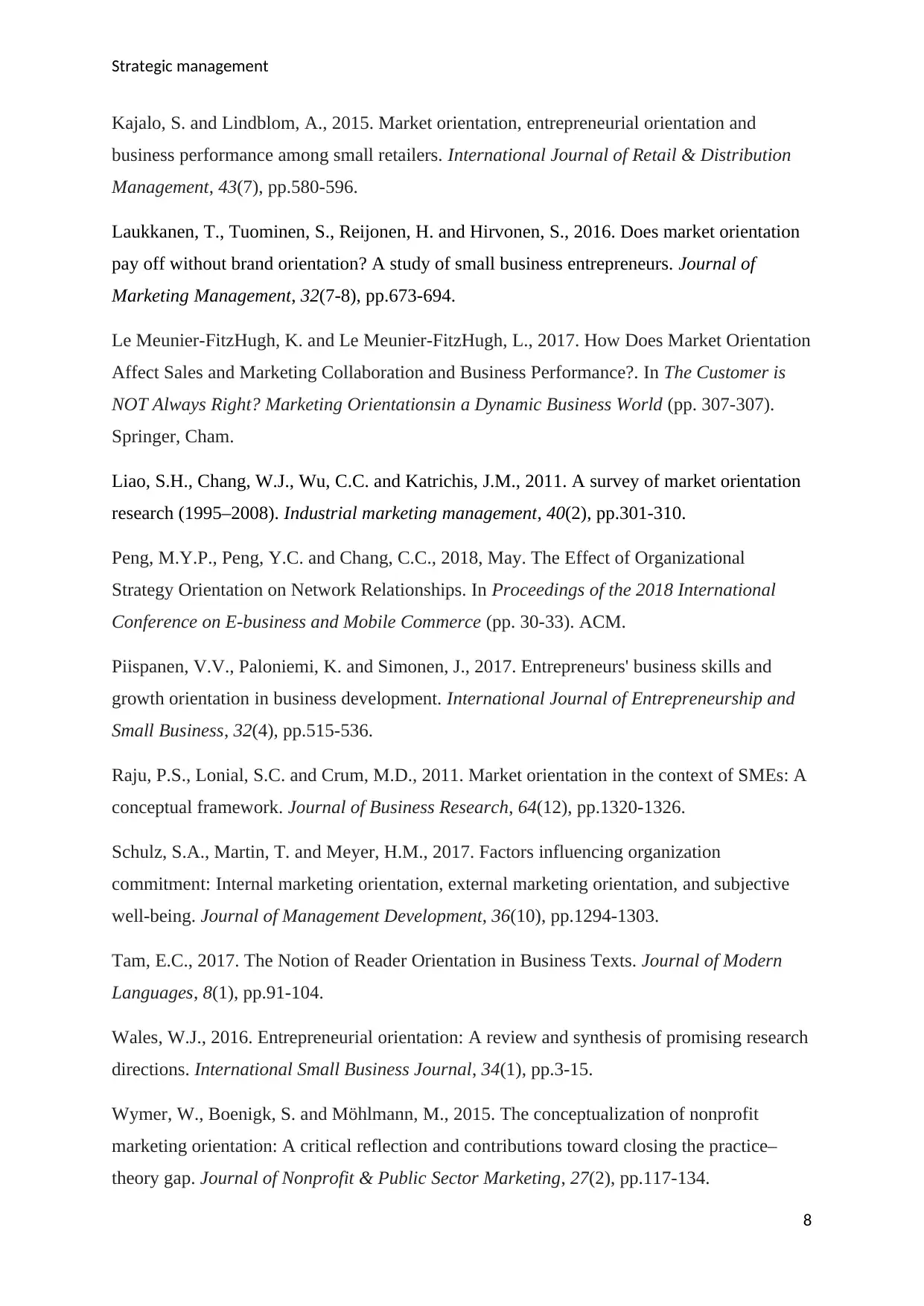
Strategic management
Kajalo, S. and Lindblom, A., 2015. Market orientation, entrepreneurial orientation and
business performance among small retailers. International Journal of Retail & Distribution
Management, 43(7), pp.580-596.
Laukkanen, T., Tuominen, S., Reijonen, H. and Hirvonen, S., 2016. Does market orientation
pay off without brand orientation? A study of small business entrepreneurs. Journal of
Marketing Management, 32(7-8), pp.673-694.
Le Meunier-FitzHugh, K. and Le Meunier-FitzHugh, L., 2017. How Does Market Orientation
Affect Sales and Marketing Collaboration and Business Performance?. In The Customer is
NOT Always Right? Marketing Orientationsin a Dynamic Business World (pp. 307-307).
Springer, Cham.
Liao, S.H., Chang, W.J., Wu, C.C. and Katrichis, J.M., 2011. A survey of market orientation
research (1995–2008). Industrial marketing management, 40(2), pp.301-310.
Peng, M.Y.P., Peng, Y.C. and Chang, C.C., 2018, May. The Effect of Organizational
Strategy Orientation on Network Relationships. In Proceedings of the 2018 International
Conference on E-business and Mobile Commerce (pp. 30-33). ACM.
Piispanen, V.V., Paloniemi, K. and Simonen, J., 2017. Entrepreneurs' business skills and
growth orientation in business development. International Journal of Entrepreneurship and
Small Business, 32(4), pp.515-536.
Raju, P.S., Lonial, S.C. and Crum, M.D., 2011. Market orientation in the context of SMEs: A
conceptual framework. Journal of Business Research, 64(12), pp.1320-1326.
Schulz, S.A., Martin, T. and Meyer, H.M., 2017. Factors influencing organization
commitment: Internal marketing orientation, external marketing orientation, and subjective
well-being. Journal of Management Development, 36(10), pp.1294-1303.
Tam, E.C., 2017. The Notion of Reader Orientation in Business Texts. Journal of Modern
Languages, 8(1), pp.91-104.
Wales, W.J., 2016. Entrepreneurial orientation: A review and synthesis of promising research
directions. International Small Business Journal, 34(1), pp.3-15.
Wymer, W., Boenigk, S. and Möhlmann, M., 2015. The conceptualization of nonprofit
marketing orientation: A critical reflection and contributions toward closing the practice–
theory gap. Journal of Nonprofit & Public Sector Marketing, 27(2), pp.117-134.
8
Kajalo, S. and Lindblom, A., 2015. Market orientation, entrepreneurial orientation and
business performance among small retailers. International Journal of Retail & Distribution
Management, 43(7), pp.580-596.
Laukkanen, T., Tuominen, S., Reijonen, H. and Hirvonen, S., 2016. Does market orientation
pay off without brand orientation? A study of small business entrepreneurs. Journal of
Marketing Management, 32(7-8), pp.673-694.
Le Meunier-FitzHugh, K. and Le Meunier-FitzHugh, L., 2017. How Does Market Orientation
Affect Sales and Marketing Collaboration and Business Performance?. In The Customer is
NOT Always Right? Marketing Orientationsin a Dynamic Business World (pp. 307-307).
Springer, Cham.
Liao, S.H., Chang, W.J., Wu, C.C. and Katrichis, J.M., 2011. A survey of market orientation
research (1995–2008). Industrial marketing management, 40(2), pp.301-310.
Peng, M.Y.P., Peng, Y.C. and Chang, C.C., 2018, May. The Effect of Organizational
Strategy Orientation on Network Relationships. In Proceedings of the 2018 International
Conference on E-business and Mobile Commerce (pp. 30-33). ACM.
Piispanen, V.V., Paloniemi, K. and Simonen, J., 2017. Entrepreneurs' business skills and
growth orientation in business development. International Journal of Entrepreneurship and
Small Business, 32(4), pp.515-536.
Raju, P.S., Lonial, S.C. and Crum, M.D., 2011. Market orientation in the context of SMEs: A
conceptual framework. Journal of Business Research, 64(12), pp.1320-1326.
Schulz, S.A., Martin, T. and Meyer, H.M., 2017. Factors influencing organization
commitment: Internal marketing orientation, external marketing orientation, and subjective
well-being. Journal of Management Development, 36(10), pp.1294-1303.
Tam, E.C., 2017. The Notion of Reader Orientation in Business Texts. Journal of Modern
Languages, 8(1), pp.91-104.
Wales, W.J., 2016. Entrepreneurial orientation: A review and synthesis of promising research
directions. International Small Business Journal, 34(1), pp.3-15.
Wymer, W., Boenigk, S. and Möhlmann, M., 2015. The conceptualization of nonprofit
marketing orientation: A critical reflection and contributions toward closing the practice–
theory gap. Journal of Nonprofit & Public Sector Marketing, 27(2), pp.117-134.
8
⊘ This is a preview!⊘
Do you want full access?
Subscribe today to unlock all pages.

Trusted by 1+ million students worldwide

Strategic management
9
9
1 out of 10
Related Documents
Your All-in-One AI-Powered Toolkit for Academic Success.
+13062052269
info@desklib.com
Available 24*7 on WhatsApp / Email
![[object Object]](/_next/static/media/star-bottom.7253800d.svg)
Unlock your academic potential
Copyright © 2020–2025 A2Z Services. All Rights Reserved. Developed and managed by ZUCOL.




